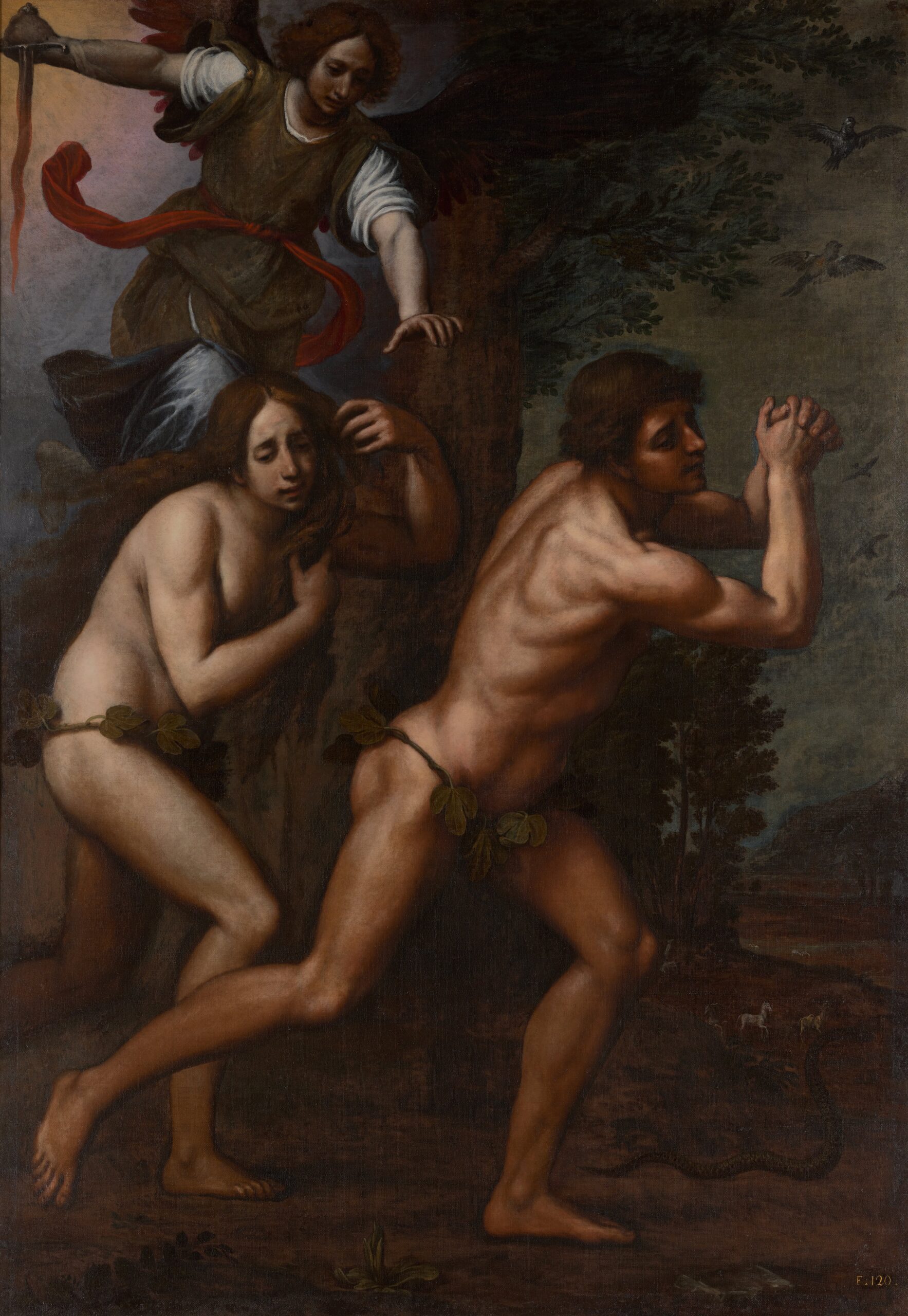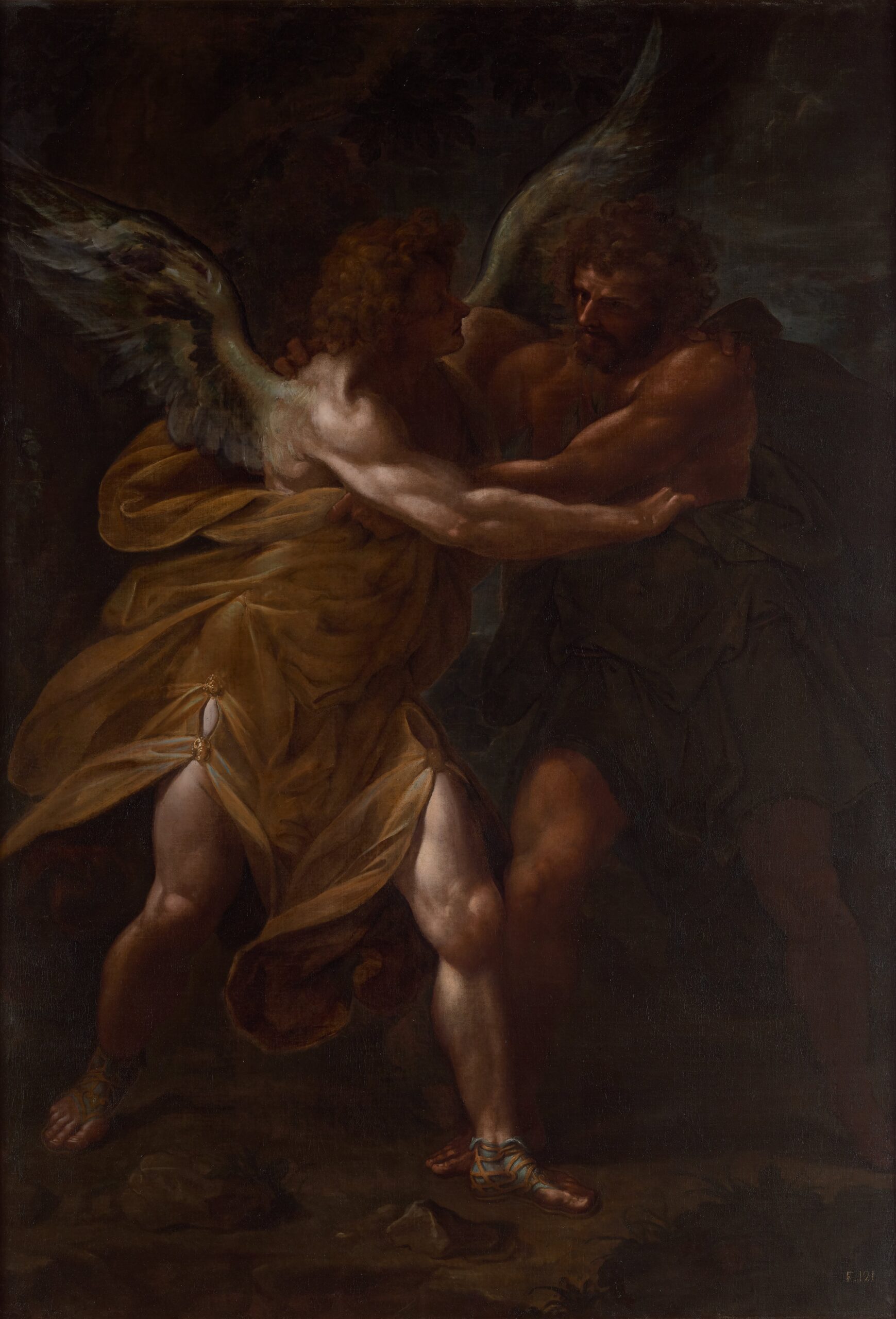Conservation Projects
Behind every work of art is ongoing care. Mia’s conservation projects safeguard paintings, sculpture, architecture, and decorative arts through meticulous research and treatment, ensuring these works remain accessible and meaningful for generations to come. Many of the works featured below are on view in the galleries—visit Mia to see these conservation stories up close.

Domenico Passignano, 1627, The Expulsion of Adam and Eve from Paradise, Oil on canvas, Gift of John Morton Morris in honor of Patrick Noon 2020.54.2
Passignano’s The Expulsion of Adam and Eve from Paradise (2023)
Passignano’s masterful depiction of the Expulsion of Adam and Eve from Paradise was once part of the Barberini collection. Acquired by Mia in 2020, it was an important addition to Mia’s collection and Baroque gallery.
The conservation began with a thorough examination of the painting under UV light, which helps identify areas that may have previously been restored and the types of coatings and varnishes used in the past. After this review, conservators carefully removed previous overpainting and the yellowing varnish, bringing the painting back to light—literally.
The painting’s original natural varnish was replaced with a synthetic version, successfully eliminating the glossy sheen as well as the darkened appearance so that the depth of the painting can be properly seen. This magnificent work is now on display in Mia’s Baroque gallery, situated with two other Barberini showstoppers.
Recent conservation funded by a grant from the Bank of America Art Conservation Project.

Cristoforo Roncalli (il Pomarancio), Italy, 1553–1626, Jacob Wrestling with the Angel, 1620s, Oil on canvas, Gift of John Morton Morris in honor of Patrick Noon, 2020.54.1
Roncalli’s Jacob Wrestling with the Angel (2021–2023)
Cristoforo Roncalli painted this nighttime scene of Jacob wrestling an angel for the future Pope Urban VIII a year or two before he became pope in 1623. The painting, given to Mia in 2020, remained with descendants of the pope’s family for nearly 400 years.
We determined that the old picture needed some TLC. The original strainer—the wooden skeleton behind the canvas—didn’t support the canvas properly; the tacks were rusted and the canvas margins thin and brittle. The surface of the painting was dirty too, making the scene difficult to see due to its yellowed, shiny varnish.
Conservators at Midwest Art Conservation Center mounted the canvas on a new stretcher, adding a fabric edge to the tacking margins, which gave the painting secure tension. The picture was then carefully cleaned and the dirty varnish removed. The conservators next applied a new, stable varnish to saturate the pigments and protect the painting, and then filled in any losses with a reversible medium.
Now cleaner, more legible, and in stable condition, Jacob Wrestling with the Angel will remain publicly accessible for generations to come.

Conservation of Frank Stella’s “Tahkt-I-Sulayman Variation II” (69.132) in gallery 374; Conservation services provided by Midwest Art Conservation Center; Project sponsored by Bank of America.
Frank Stella’s Tahkt-I-Sulayman Variation II (2018)
Grant funds from Bank of America were used to conserve the Minneapolis Institute of Art’s painting Tahkt-I-Sulayman Variation II (1969) by Frank Stella. The painting required structural and cosmetic treatment, including cleaning the surface of the work to remove dust, dirt, and fingerprints.
A few areas were marred by mechanical damage and accretions, and there was a small puncture in one area of the painting. Treatment reduced and removed surface accretions when possible and repaired the puncture. The reverse of the canvas also required cleaning, and the strainer was replaced to maintain proper tension of the canvas support. Finally, backing boards were added to significantly improve the structural integrity of the piece. In addition to supporting the conservation of this important work, funds from Bank of America were used to create a related video on this incredible painting.
Conservation generously funded by a grant from the Bank of America Art Conservation Project.
![]()
Purcell-Cutts House Window Conservation Project
From June through September 2016, a small team repaired eight windows from the Purcell-Cutts House that suffered from grout failure and wood rot and degradation. Most of these windows are from the front (east) façade of the house. Gillian Thompson, a stained-glass specialist, along with conservators from the Midwest Art Conservation Center (MACC) in Minneapolis, removed old grout from the art glass and regrouted the windows and repaired areas of damaged zinc came (the metal channels that hold together the glass panes). They conducted this work under the supervision of art glass conservator Drew Anderson of New York City.
Nicholas Doyle of Chiral Arts LLC of St. Paul, with consultation from Stuart MacDonald, AIA, of Minneapolis, carefully removed areas of damaged paint and rotted wood from the sashes. He then replaced degraded wood where necessary and repainted the sashes, which were reunited with the glass at MACC.
The conserved and cleaned windows now better convey Purcell and Elmslie’s vision for them—as an integral connection between life inside the house and the changing natural world outside.
This project has been financed in part with funds provided by the State of Minnesota from the Arts and Cultural Heritage Fund through the Minnesota Historical Society.

Max Beckmann’s Blind Man’s Buff (2013)
Of Max Beckmann’s nine triptychs, Blind Man’s Buff is the largest and arguably the most important. The work was painted during Beckmann’s exile in Amsterdam between September 1944 and October 1945, under difficult wartime circumstances. In his journal, Beckmann refers to air raids and lack of food, coal, and electricity; in fact, much of the triptych was painted by candlelight.
Since the Minneapolis Institute of Art acquired it in 1955, Blind Man’s Buff has consistently ranked among the museum’s top-five important artworks. Despite its controlled environment, the triptych had grown increasingly fragile, its structure unstable and surface deteriorating. The triptych’s conservation treatment was conducted over a four-month period in 2013 by the museum’s art conservation provider, the Midwest Art Conservation Center (MACC), under Mia’s supervision. MACC is a nonprofit regional conservation facility housed within the museum, making frequent conservator-curator consultation throughout the treatment possible.
Conservation generously funded by a grant from the Bank of America Art Conservation Project.
![]()
Saint Paul the Hermit (2012)
Acquired by the Minneapolis Institute of Art in 1973, the statue of Saint Paul the Hermit remained a mystery for the longest time. It was exhibited with an attribution to the 17th-century sculptor Francesco Mochi, when in fact the sculpture was made more than a full century later, by the important sculptor Andrea Bergondi. (Bergondi continued to employ a Baroque visual language despite the dawn of Neoclassicism.) Moreover, the statue had been mounted in an awkward way in the 1960s, tipped forward by about 45 degrees, which impeded its correct reading and understanding.
An exhibition during the Spring of 2012 documented the research and conservation process that took place to restore this statue to its original position and glory. It also shed light on other aspects, from carving technique and construction to the sculpture’s original context, meaning, and history.
The conservation was carried out by senior objects conservator Donna Haberman and associate objects conservator Nicole Grabow of the Midwest Art Conservation Center (MACC).
Generous support for restoration provided by Friends of the Institute
![]()
The exhibition was supported by the Samuel H. Kress Foundation.
Guercino’s Erminia and the Shepherds (2004)
Over the course of ten weeks in the fall of 2004, paintings conservators Joan Gorman and David Marquis of the Midwest Art Conservation Center conducted a major conservation treatment of Guercino’s Erminia and the Shepherds during public viewing hours. Visitors to the Minneapolis Institute of Art could observe each stage of the restoration process, as the conservators restored the painting to its original appearance of 350 years ago.
This exhibition was made possible with generous support from American Express, the Samuel H. Kress Foundation, the Marbrook Foundation, and the Paintings Curatorial Council of The Minneapolis Institute of Arts.

Giovanni Benedetto Castiglione, The Immaculate Conception with Saints Francis of Assisi and Anthony of Padua.
Castigilione’s The Immaculate Conception (1999)
Over the course of 7 weeks in the fall of 1999, members of the Midwest Art Conservation Center cleaned and restored Giovanni Benedetto Castiglione’s The Immaculate Conception with Saints Francis of Assisi and Anthony of Padua, a masterwork and one of the largest paintings in the Minneapolis Institute of Art’s collection.
The painting had undergone changes due to aging, deterioration, and damage in the 350 years since its creation. These ongoing changes necessitated restoration measures in the past, and thus the treatment may be the painting’s third or fourth major conservation. Even though a painting and the materials added during conservation age as one, the materials added to the Castiglione during old restorations had become problematic. All of the above factors produced condition problems that necessitated both structural and cosmetic changes.




